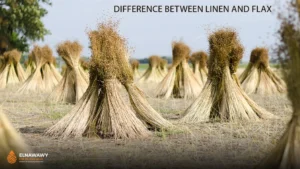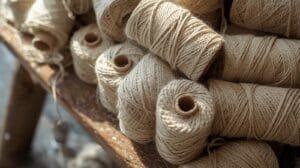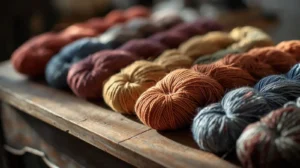Best Yarn for Crafts
Choosing the best yarn for crafts isn’t just about color or softness—it’s about performance, texture, and the story your handmade piece tells.

On this page
Introduction Understanding Yarn Types Best Yarn for Crafts Yarn Finder (Quiz) Role of Natural Fibers Fiber Strengths What Is the Best Yarn? Eco Yarn & Sustainability Texture & Weight Why Linen & Hemp Compare Fibers Tips to Choose Order & ContactEvery crafter knows that the right yarn can elevate a simple project into a durable, professional-quality creation.
Whether you’re making macramé wall art, cozy knitted pieces, or eco-friendly décor, selecting the right fiber—cotton, linen, or hemp—defines the outcome.
Understanding how each yarn behaves helps you pick materials that not only look stunning but also stand the test of time.
Understanding Yarn Types for Crafting
Before choosing the best yarn for crafts, it’s essential to understand the basic categories available. Yarn isn’t just a thread—it’s a combination of texture, material, and purpose. Each fiber type has unique qualities that influence how your craft looks and feels.
Cotton Yarn: Known for its softness and breathability, cotton yarn is ideal for summer crafts, dishcloths, and macramé projects. It holds its shape well and doesn’t stretch much.
Linen Yarn: Made from flax fibers, linen yarn offers incredible strength and a smooth finish. It’s perfect for crafts that need durability and a natural texture, such as wall hangings and woven table runners.
Hemp Yarn: Durable, rustic, and eco-friendly, hemp yarn is a favorite among sustainable crafters. It’s perfect for bags, plant hangers, and sturdy craft projects.
Wool Yarn: Offers warmth and elasticity, making it a great choice for garments, scarves, and knitted crafts.
Blended Yarn: Many crafters use blends like cotton-linen or hemp-cotton for balanced texture and flexibility.
Choosing the right fiber type ensures your project not only looks great but also lasts longer.
Best Yarn for Crafts
Not every yarn works well for every craft. The best yarn for crafts combines texture, durability, and sustainability. When comparing options, consider:
Texture: Smooth yarns are ideal for detailed patterns, while rougher textures create rustic appeal.
Thickness (Ply): Fine yarns are perfect for delicate crafts, whereas thicker plies add structure to larger items.
Durability: For items that face regular use, such as bags or décor, choose strong natural fibers like hemp or linen.
Eco-Friendliness: As sustainability grows in importance, many artisans now prefer biodegradable, eco-friendly yarns that reduce waste.
Color Retention: High-quality natural yarns maintain their color better than cheap synthetic alternatives.
Understanding these characteristics ensures that every stitch or weave contributes to a long-lasting and visually appealing creation.
Find the Right Yarn
Select your use case and get a suggestion:
The Role of Natural Fibers in Modern Crafts
Natural yarns—like cotton, hemp, and linen—are making a strong comeback in the American craft market. They not only provide excellent performance but also align with the growing eco-conscious mindset of modern makers.
Cotton Yarn: Loved for its softness and vibrant color options. Excellent for crochet crafts and home décor items.
Linen Yarn: A top choice for artisans seeking elegance and resilience. It softens with every use while maintaining its strength.
Hemp Yarn: Highly durable and antimicrobial. Ideal for outdoor crafts, coasters, and macramé designs.
Jute Yarn: Perfect for rustic-themed crafts, gift wrapping, or handmade baskets.
Using natural yarns allows crafters to create sustainable, timeless pieces that appeal to both the eye and the planet.
Fiber Strengths at a Glance
What Is the Best Yarn for Crafts?
The best yarn for crafts can vary significantly based on what you’re making. Here’s how to match your yarn to your project type:
🧶 For Knitting and Crochet
Soft fibers such as cotton, wool, or blended yarns are preferred. They glide smoothly through the needles, making them great for scarves, sweaters, and hats.
🪡 For Weaving Projects
Linen and hemp yarns are excellent due to their strength and tension resistance. They produce crisp, professional weaves that hold their shape.
🎨 For Macramé and Wall Art
Hemp and jute yarns are top picks. They create texture and body, enhancing the aesthetic of bohemian or rustic designs.
🏡 For Home Décor and DIY
Cotton and linen yarns are best for creating eco-friendly, long-lasting pieces like placemats, coasters, and baskets.

Sustainability and the Shift Toward Eco Yarn
The demand for eco-friendly yarn is rising rapidly across the United States. Crafters today care not only about the final product but also about the environmental footprint behind it.
Sustainable yarn options like flax (linen) and hemp yarn are biodegradable, require less water to produce, and last much longer than synthetic yarns. These natural fibers also add a distinct tactile quality that gives handmade crafts authenticity and warmth.
Many U.S. artisans now highlight “made with sustainable yarn” in their product descriptions because it attracts conscious buyers and reflects responsible craftsmanship. If you’re building a crafting brand or selling handmade products, using sustainable yarn materials can enhance your value and credibility.
Yarn Texture and Weight: Finding the Perfect Balance
Yarn weight influences both the appearance and usability of your craft. For instance:
Lightweight yarns (fingering, sport) are perfect for lace or fine details.
Medium-weight yarns (DK, worsted) suit general crafts, home décor, and weaving.
Heavy yarns (bulky, super bulky) work best for statement pieces and structural projects.
Texture matters too. A smooth yarn helps highlight patterns and stitches, while a slightly coarse yarn adds dimension and a hand-crafted feel. For most general craft projects, a medium-weight linen or cotton yarn offers the perfect combination of strength and flexibility.
Why Crafters Prefer Linen and Hemp Yarns
Durability: They resist stretching and fraying better than cotton.
Eco-benefits: Both are renewable and biodegradable.
Unique Finish: They add a rustic, authentic character to every project.
Versatility: Suitable for weaving, knitting, wrapping, and macramé.
Crafters who want professional-quality results with a natural touch often consider these fibers the best yarns for crafts.
Compare Fibers
Linen vs Cotton: Linen is stronger and more breathable; cotton is softer and stretchier. Deep dive: linen vs cotton.
Tips for Choosing the Best Yarn for Your Craft Project
Know Your Technique: Different crafts require different yarn tensions and textures.
Check Fiber Source: Prefer natural fibers for sustainability and tactile comfort.
Test a Sample: Before committing, try a small sample to see how the yarn behaves.
Prioritize Quality Over Price: Cheap yarns may break or lose color over time.
Match Yarn Weight to Tool Size: Use needles or hooks that complement the yarn’s thickness for better results.
If you’re crafting for commercial purposes, consistency and color stability are key—so choose yarns from reputable suppliers offering reliable natural fibers.





